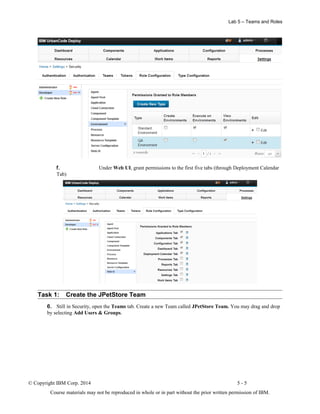Security lab
- 1. Lab 5: Teams and Roles Objectives After completing this lab, you will be able to: ► Create a new role ► Create a JPetStore team ► Associate the team to the existing JPetStore application and environments ► Login as a JPetStore developer Given ► The JPetStore app, db, web files located on the same server as the installed IBM UrbanCode Deploy Scenario Authentication deals with verifying the user as he or she logs in; authorization deals with what rights the user has once they are on the system. When the IBM UrbanCode Deploy product is first set up internal user accounts are created and maintained within the tool. In this lab you use authentication for a new user that logs into UrbanCode Deploy. Most active systems will include an LDAP realm as well. Authorization is based on a set of roles, applied to a set of teams, applied to a set of objects. Each role defines a set of actions. Each team contains of users, assigned to roles. Objects are things like applications, environments, and components. © Copyright IBM Corp. 2014 5 - 1 Course materials may not be reproduced in whole or in part without the prior written permission of IBM.
- 2. Essentials of IBM UrbanCode Deploy — Student Workbook Task 1: Create a new user in the internal security realm 2. From the top-level Settings tab, click on Security > Authentication (Users) 3. Click the Create User button and create a new user: ID: ben User Name: Ben Franklin Password: ben Task 1: Create a Developer role 4. In Security, open the Role Configuration tab. Click on Create New Role to create a role. 5 - 2 © Copyright IBM Corp. 2014 Course materials may not be reproduced in whole or in part without the prior written permission of IBM.
- 3. Lab 5 – Teams and Roles 5. Click on the newly created Developer role and add the following actions: a. Under Application, for the Standard Application select View Applications and select Run Component Processes from the drop down selection list under Edit. © Copyright IBM Corp. 2014 5 - 3 Course materials may not be reproduced in whole or in part without the prior written permission of IBM.
- 4. Essentials of IBM UrbanCode Deploy — Student Workbook b. Under Component, grant the View Components permission for the Standard Component. c. Under Environment, Create a New Type called QA Environment d. Under Environment, grant Execute on Environments and View Environments to Standard Environment. e. Under Environment, grant View Environments to QA Environment. 5 - 4 © Copyright IBM Corp. 2014 Course materials may not be reproduced in whole or in part without the prior written permission of IBM.
- 5. Lab 5 – Teams and Roles f. Under Web UI, grant permissions to the first five tabs (through Deployment Calendar Tab) Task 1: Create the JPetStore Team 6. Still in Security, open the Teams tab. Create a new Team called JPetStore Team. You may drag and drop by selecting Add Users & Groups. © Copyright IBM Corp. 2014 5 - 5 Course materials may not be reproduced in whole or in part without the prior written permission of IBM.
- 6. Essentials of IBM UrbanCode Deploy — Student Workbook 7. Add Ben to the JPetStore Team as a Developer. 8. Save the new team definition. Task 1: Apply the team to the existing JPetStore application 9. Now apply the rules that have been defined to the existing application. g. From Applications, select JPetStore. Select Configuration > Basic Settings. h. Expand the Teams and Add the JPetStore Team. Click Add and Save. 5 - 6 © Copyright IBM Corp. 2014 Course materials may not be reproduced in whole or in part without the prior written permission of IBM.
- 7. Lab 5 – Teams and Roles Update the SIT environment to include JPetStore Team with a Standard Environment Role: 10. From Applications>JPetStore>SIT, select Configuration>Basic Settings. Click Add and Save. Update the UAT environment to include the JPetStore Team with a QA Environment Role: 11. From Applications>JPetStore>UAT, select Configuration>Basic Settings. Click Add and Save. © Copyright IBM Corp. 2014 5 - 7 Course materials may not be reproduced in whole or in part without the prior written permission of IBM.
- 8. Essentials of IBM UrbanCode Deploy — Student Workbook Since the name of each environment is just a tag – the IBM UrbanCode Deploy system does not understand the semantics of SIT versus UAT and using environment roles provides a way to define different security rules around the environment type. Task 1: Log in as a JPetStore Developer 12. Log out of IBM UrbanCode Deploy as admin by clicking Sign Out from the admin drop-down menu. 13. Log in with username Ben Franklin and password ben. Notice fewer high-level tabs are available. This was done through configuring the Web UI. Notice also that, although Ben can see UAT, and compare the content against other environments, he does not have the rights to do a deployment. 5 - 8 © Copyright IBM Corp. 2014 Course materials may not be reproduced in whole or in part without the prior written permission of IBM.







